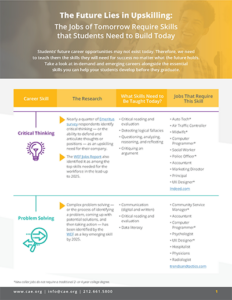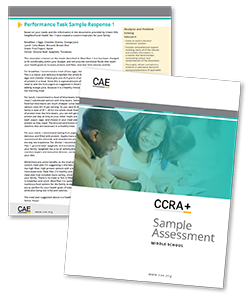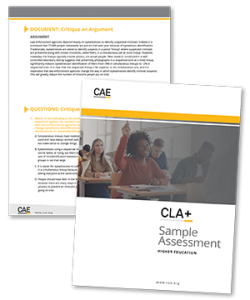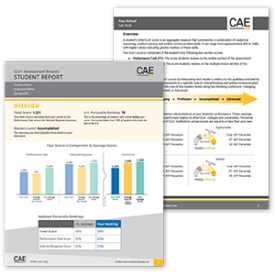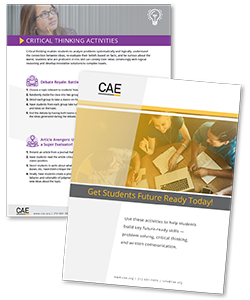Higher-Order Skills Assessments Help Students Achieve Their Academic and Career Goals
Are you interested in learning more about higher-order skills and using performance-based assessments to measure and teach these important skills? Contact us and let’s chat about developing a program to help your students build the skills needed to succeed in school and the workplace.
Improve Students’ Employability with Higher-Order Skills Assessments
How do we prepare students for the jobs of the future? The economy and job market are rapidly changing and will continue to change long after students graduate. Academic or industry-specific training alone is no longer sufficient for life-long success in the workplace. We can set students up today for tomorrow’s jobs — whatever they may be — by measuring and teaching higher-order skills.
Higher-order skills are a set of personal attributes and abilities that allow individuals to thrive in a professional setting. At their core, these include effectively interacting with others, communicating successfully, and being able to think critically to solve problems. Decades of research confirms the need to teach students higher-order skills through quality assessment and instruction that includes worked examples and practice. In response, school districts, higher education institutions, and even the Department of Education are shifting instructional and assessment approaches to be more competency based.
To help students prepare for an ever-changing job market, schools should prioritize higher-order skill instruction, practice, and assessment.
Why Higher-Order Skills Assessments Are Important
There are many ways higher-order skills help students perform well academically and in their professions. They give students the ability to:
- Think critically
- Solve problems
- Collaborate with others
- Communicate effectively
- Be creative
- Build professional relationships
- Produce high-quality work independently
- And more!
Higher-order skills can also improve employability. When an employer is hiring for a position, they are typically looking for candidates who can work for the company for a long time. This means the candidates need to be able to learn and grow over time, work well with others, think critically to solve problems, and show curiosity and initiative.


Skills Employers Desire Versus the Skills Students Are Learning In High School and College
As the rate of technological change continues to increase and transform the workplace, employers across industries are seeking employees with strong higher-order skills in order to keep pace and adapt.
The skills most in-demand include the ability to build relationships, solve problems, collaboration, and effective communication.
Yet high schools and colleges on the whole are not meeting employers’ current needs. A six-year international research study conducted by the Council for Aid to Education (CAE) and the Organization for Economic Co-operation and Development (OECD) found that 60% of students entering colleges and universities are not proficient in higher-order skills and 44% of exiting students are still not proficient. A global survey conducted by McKinsey in 2020 found that 90% of executives and managers are seeing (or soon expect) a skills gap in their organizations, a gap that will be a risk to the success of their company. This worrying trend is far-reaching and is becoming a severe issue in many countries, compromising productivity, growth, and even the success of businesses.
Secondary Schools and Higher Education Institutions Can Measure and Teach Higher-Order Skills — Which Are Predictive of Improved Academic and Career Outcomes
Assessing higher-order skills can be an effective way to identify students’ strengths and areas of needed growth with critical thinking, problem solving, and written communication — skills most in-demand by employers.
Research published in the European Journal of Education shared key findings of the international study conducted by CAE and OECD, including that it is feasible to reliably and validly measure higher-order skills in a cross-cultural context. Additionally, researchers found that assessment of these skills is necessary for colleges and universities to ensure that their programs are graduating students with the skills needed for career success after graduation.
Students (n=120,000) from higher education institutions in six different countries — Chile, Finland, Italy, Mexico, the UK, and the US — were administered CAE’s Collegiate Learning Assessment (CLA+) between 2015 and 2020. This performance-based assessment measures student proficiency with critical thinking, problem solving, and written communication.
Students entering a higher education program on average performed at the Developing mastery level while exiting students on average performed at the Proficient mastery level. The amount of growth is relatively small (d = 0.10), but significant. However, half of exiting students performed at Emerging or Developing proficiency, indicating that they were not provided with opportunities to build their higher-order skills through their college or university coursework. This research points to a growing skills gap between what colleges are teaching and what employers need. But, both secondary and higher education institutions are beginning to take notice.
One example is Texas A&M University’s Mays Business School. In response to feedback from employers that their graduates lack critical thinking and other higher-order skills, the school partnered with CAE in 2021 to develop a program to measure and teach these essential skills. The program includes performance task assessments and in-depth instruction in critical thinking and problem solving.
Early research into the impact of the program on students’ higher-order skills is impressive. Seniors who received critical thinking instruction during the 2021–22 academic year performed significantly higher on the CLA+ than those who hadn’t received explicit instruction. Not only do the assessment results demonstrate that Mays graduates possess the higher-order skills employers most want, the school’s leadership can be confident that their students are truly positioned for success. Strong performance on the CLA+ is predictive of positive post-secondary outcomes as measured by employment, salary, and graduate school enrollment. Additionally, students with higher levels of proficiency with higher-order skills are more likely to have higher evaluations from their managers and advisors.

{Guide} Future Careers Are Built in Today’s Classrooms
Are your students prepared for their careers? Download this guide to view in-demand and emerging careers alongside the higher-order thinking skills you can help your students develop to prepare for success in these jobs before they graduate.
Get Started Using a Higher-Order Skills Assessment Tool
Educators who understand the importance of higher-order skills and are ready to start assessing and teaching these skills to students should consider CAE’s suite of products. We offer performance-based assessments, instructional materials, practice models, and professional development. Our tools are designed for middle/high school students as well as postsecondary students.
PERFORMANCE-BASED ASSESSMENTS

INSTRUCTIONAL MATERIALS

PROFESSIONAL DEVELOPMENT

Our tools are designed for middle/high school students as well as postsecondary higher education students.
- Measuring students’ higher-order skills
- Using the higher-order skills data to inform instruction and tailor interventions
- Integrating explicit instruction of higher-order skills across curricula
- Providing opportunities for deliberate practice of these skills
- Supporting educators with quality professional development
- Supporting education leaders with data and actionable insights
Get started building students’ higher-order skills today to support their future academic and career goals.
Use CAE’s Higher-Order Skills Assessments to Measure Student Competency
CAE’s College and Career Readiness Assessment (CCRA+) for secondary education and Collegiate Learning Assessment (CLA+) for higher education measure student proficiency in critical thinking, problem solving, and written communication.
Schools, districts, and higher education institutions can conduct a baseline assessment of entering students to better understand where they are regarding these higher-order skills and where to best apply resources, instruction, and interventions. Assessments can be re-administered throughout the year, and at the start of each new school year, to monitor progress and measure growth with higher-order skills.
How Do CCRA+ and CLA+ Work?

REAL-WORLD SCENARIOS
Students are situated in real-world scenarios that require the application of critical thinking, problem-solving, and written communication skills.

RECOMMEND A SOLUTION
Using supplied reference materials, students must organize information, define the problem, address issues, and recommend and defend a course of action.

NO SINGLE "RIGHT" ANSWER
Student scores reflect a range of plausible and effective response strategies — a process that, by design, mimics real-world decision environments.
Our performance-based CCRA+ and CLA+ higher-order skills assessments provide insightful, nuanced evidence of students’ competencies in these areas so they can work to develop essential higher-order skills.
Take a look at these sample performance-based assessments to see how they place students in real-world scenarios and ask them to use higher-order skills to recommend a solution.
Preview CCRA+ (Grades 6–12) & CLA+, (Higher Education)
Utilize Higher-Order Skills Assessment Data to Take Action
Our higher-order skills assessments provide actionable insights to support student growth. We offer reports for individual students as well as institution reports that show school-wide higher-order skills trends.
Take a look at our report offerings.
Student reports provide each student with a summary of their results, detailing which higher-order thinking skills they’re strongest in and which have room for growth. Students receive their current mastery level, skills and subskills scores along with a comparison of peers within their institution and across CAE’s U.S. norm sample. These data can be used as a roadmap to guide students and educators in charting a course to develop the skills needed to achieve their academic and career goals.
Institution reports provide an overview of a school, district, or higher education institution’s scores in aggregate form. They show how the scores compare to CAE’s validated, normed sample, and which higher-order skills should be prioritized for instruction. Educators and data teams can use these data to plan instruction and target interventions that will better prepare students for their futures.
Our data reports make it easy for educators to take action on higher-order skills assessment data by using it to:
- Identify school-wide trends and also specific students who need additional supports
- Understand students’ strengths to inform your instruction and intervention strategies
- Implement your plan to meet their specific needs and prepare them for future success
- Inform constituents of the progress and impact of your program
Here are some examples of how the data can be used to support student growth:
![]()
State, district, and school leaders can use the data to:
- Identify overall mastery of higher-order skills and student growth across grade levels
- Compare student scores to CAE’s extensive national data sample
- Measure the effectiveness of instruction and interventions
- Track goals for the district’s strategic plan and for students’ college and career readiness
![]()
Teachers, counselors, and academic advisors can use the data to:
- Gain insight into students’ strengths and opportunities for growth
- Create targeted intervention and supports
- Guide classroom instruction
![]()
Students and families can use the data to:
- Identify their competence in higher-order skills
- Evaluate how they compare to peers in their institution and across CAE’s national sample.
- Develop a plan to build higher-order skills
Teach Students Higher-Order Skills with CAE’s Instructional Materials
CAE’s higher-order thinking skills instructional materials, activities, and practice performance-based assessments will help students build the essential skills they need to succeed now and in the future.
Here are a few examples of our instructional materials:
Classroom activities include a range of activities that can be woven into your curricula and will help students build their problem-solving, critical thinking, and written communication skills.
Instructional materials provide students with real-life scenarios where they have to apply higher-order skills such as critical thinking, problem solving, and information analysis to address a problem and provide a solution.
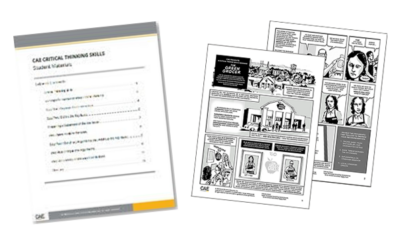
Support Educators with Higher-Order Skills Professional Development
CAE provides quality professional development to ensure educators are able to build students’ higher-order skills. Our customizable support gives educators the tools and data needed to develop courses, programs, and supports to improve their students’ higher-order skills and prepare them for success after graduation. We offer a range of training formats, including:
- In-person or virtual training sessions
- Ongoing support and coaching
- Workshops to help you use your higher-order skills data to guide instruction and interventions
Our higher-order skills experts are here to support your institution and ensure your higher-order skills assessment and instruction program is a success.

Learn More About CAE’s Higher-Order Skills Assessments
Schedule a demo to learn more about our secondary and higher education higher-order skills assessments and instructional materials. We’ll walk you through our higher-order skills assessment tools and chat about how CAE can help you prepare students for academic and career success.
